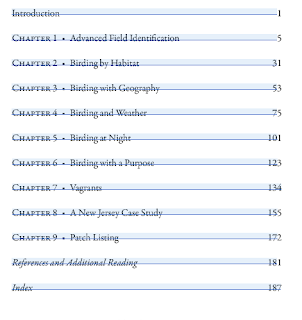By Derek Lovitch
"Quite possibly the biggest step to becoming a better birder is learning how to identify more birds. No one can identify every bird at all times...but we do want to strive to identify most of the birds most of the time. And I don't mean when the bird is sitting still for 15 minutes on a feeder 25 feet from your window. I'm also talking about identifying that flitting warbler in a tangle, the sparrow flushing from the grass, that soaring raptor spotted out of the corner of your eye while you're driving 75 miles an hour on the interstate. Yes it can be done, and yes, you can do it!"
Early on in this book, author Derek Lovitch explains the gist of how he thinks you can become a better birder, using what he calls the "whole bird and more" approach:
"Classic birding, which uses the field mark system, focuses almost exclusively on appearance: wingbars, eye rings, color patterns, and so on. However, the 'holistic'--or as I prefer, 'the whole bird and more'--approach takes everything into consideration. It goes beyond GISS (general impression of size and shape, or gestalt) and combines that with field marks and the how, what, where, and when's. Look at the whole bird, what it's doing, and where it is doing it. This is what I mean by the 'whole bird and more' "
He also says "I firmly believe that we need to put the 'watching' back in 'birdwatching'...you need to watch birds! How does the bird move? What is it shaped like? What is it doing? What is it feeding on? Where is it feeding? Size? Shape? In other words, 'What does it look like' is only one question that should be answered."
So that is the philosophical heart of his treatise - put the "watching" back in "birdwatching" Having just reviewed Petrels, Albatrosses and Storm-Petrels of North America and remarked that identifying these seabirds was challenging and required a different "observational mindset", I must say I am on board with his supposition! This also is talked about in the introductuion of the terrific Crossley ID Guide (Eastern Birds) when author Richard Crossley mentions "Looking verus Seeing". I think I'm detecting a pattern.
A strong point of this book is the delineation of additional resources. For example, in the chapter on "Birding and Weather", when he mentions that "you'll want to have an understanding of some of the basic concepts in meteorology", he gives you an online reference for learning this material: the National Weather Service's "Jetstream--Online School for Weather found at http://www.srh.noaa.gov/jetstream. The whole book is like this - plenty of additional references so you can learn more.
A look at the Table of Contents (shown above) reveals what I would call the author's interdisciplinary approach. You end up becoming a better birder by learning about trees, and shrubs (Habitat), meteorology (Birding and Weather), and NEXRAD radar (Birding at Night) to name just a few of the additional topics.
In conclusion,. I would say reading this book, and the additional references will make you a better birder. His "holistic" approach will add to your identification skills and ultimately increase your enjoyment of birding, and you can't beat that with a stick!
By Matt Boer, Eric Newton, and Robin Restall
The book starts you out on a good note -- a great cover -- a picture of a beautiful bird that breeds on all three of the islands: the Ruby-topaz Hummingbird. This is one bird to look forward to seeing on your trip to these islands off the coast of Venezuela.
The strongpoints of this book are (1) Inclusiveness of species (2) Artwork and (3) Useful, concise Species Accounts.
If there is a bird that has ever been seen on any of these three islands it is in this book! I like the wonderful artwork created by Robin Restall. Kudos. The Species accounts give you descriptions of the birds appearance and song, and even include a little detail that I like: the name of the bird in the local language i.e. you can meet some locals by pointing out a Tropical Mockingbird and say "Chuchubi"! I'll just bet they'll like that and you have made a friend!
In addition to the Ruby-topaz Hummingbird, a beautiful bird to look for that is a regular visitor from North and South America, is the Fork-tailed Flycatcher.
All in all, if you are heading out to the ABC Islands, this book is an invaluable companion for a birdwatcher.
************

Bachman's Warbler
John James Audubon
Buy This at Allposters.com

Pileated Woodpecker
John James Audubon
Buy This at Allposters.com

Long-Billed Curlew
John James Audubon
Buy This at Allposters.com

Audubon: Bunting, 1827
John James Audubon
Buy This at Allposters.com

Passenger Pigeon
John James Audubon
Buy This at Allposters.com

Audubon: Towhee
John James Audubon
Buy This at Allposters.com

Audubon: Goldfinch
John James Audubon
Buy This at Allposters.com

Bay Breasted Wood-Warbler
John James Audubon
Buy This at Allposters.com

Audubon: Thrush
John James Audubon
Buy This at Allposters.com

Carolina Parrot
John James Audubon
Buy This at Allposters.com

Long-Tailed Duck
John James Audubon
Buy This at Allposters.com
************

Bachman's Warbler
John James Audubon
Buy This at Allposters.com

Pileated Woodpecker
John James Audubon
Buy This at Allposters.com

Long-Billed Curlew
John James Audubon
Buy This at Allposters.com

Audubon: Bunting, 1827
John James Audubon
Buy This at Allposters.com

Passenger Pigeon
John James Audubon
Buy This at Allposters.com

Audubon: Towhee
John James Audubon
Buy This at Allposters.com

Audubon: Goldfinch
John James Audubon
Buy This at Allposters.com

Bay Breasted Wood-Warbler
John James Audubon
Buy This at Allposters.com

Audubon: Thrush
John James Audubon
Buy This at Allposters.com

Carolina Parrot
John James Audubon
Buy This at Allposters.com

Long-Tailed Duck
John James Audubon
Buy This at Allposters.com







No comments:
Post a Comment